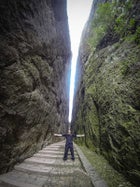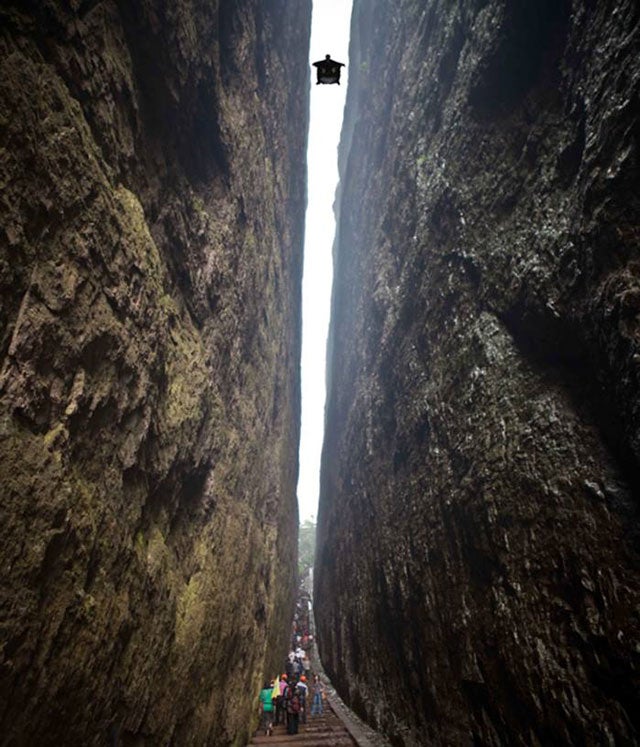On September 28, aerial stuntman Jeb Corliss plans to jump out a helicopter and pilot his wingsuit through a 30-foot-wide fissure in a nearly 900-foot-tall fin of rock, called Mount , in China. The stunt, which Corliss is dubbing “The Flying Dagger,” requires that he fly with more precision for a longer period of time than he ever has before. And he says pulling off such sustained control isn’t even the scariest part of what he’s attempting.
Video:
See what Jeb Corliss sees (at 5:50)Jeb Corliss at Mount Jianglang
 Jeb Corliss standing in the crack at Mount Jianglang
Jeb Corliss standing in the crack at Mount JianglangMount Jianglang
 Mount Jianglang
Mount JianglangIt’s been a rough year for BASE jumpers. So far in 2013 there have been in the sport, the deadliest year on record, according to ., arguably the biggest name in the game, has had his share of close calls. Last year he crashed into South Africa’s Table Mountain while flying at more than 100 miles per hour. He from near kidney failure and a torn up left leg, then jumped off the same mountain where he got hurt. He’s also helped organize the world’s first proximity wingsuit race in China, had surgery to fix a torn ACL, and jumped all over Europe. Now he’s organized his most challenging stunt to date. We called him up to hear more about how he plans to take a stab at the “Dagger.”
OUTSIDE: Where did you get the idea for “The Flying Dagger”?
CORLISS: Frank Yang of contacted me in late April or early May and wanted to know if I thought it was possible to fly through this crack in China. Normally, when non-jumpers come to me with something like that, I’m really skeptical. They don’t really understand what we do.
They flew me out and took me to three locations that were all very cool, very remote, and very unique. I thought, “OK, these are cool. I could do any one of these.” Then the final spot they took me to was this crack. When I got there I was like, “Wow, I’ve never seen anything like this.” I didn’t understand how nature could create something like it, with almost perfect 90-degree lines. I walked into the bottom and put my arms out. I had four feet on either side of me.
It’s just not that it’s narrow; it’s also really long. It’s three football fields long. It’s about 15 feet at the bottom and 60 feet at the top. So you’re looking at two people holding hands at the bottom and maybe a bus at the top. It was a very shocking thing to be standing in. My friend Iiro said, “Is this possible?” I said, “Yeah, it is possible. This can totally be done.”
What will be different about this flight?
A lot of us have done a lot of very precise flights, like I’ve hit the string on balloons, and gone by the arms of , and . But in those jumps I was only super precise for a split second—two seconds max. This time, I’m going to have to be super precise for somewhere between 10 to 30 seconds. The length of time makes it different.
This is also a very committed jump, because once you’re in you just can’t come out of it. It’s so narrow that you can’t deploy inside of it. You have to come out of the crack before you pull your parachute. It’s a very committed flight. Once you enter, you have to complete it. The deeper you go the narrower it gets.
Do you know how you are going to get into, and out of, the jump?
Well, here is the thing. I actually just went to Hungary where we are using to test our ability to render this mountain or canyon in space. So, I am able to jump out of an airplane and three times during each jump. This thing is rendered three dimensionally in front of me. It was interesting training, and I would say I impacted about 50 percent of the time.
Wait—you crashed during half of your training runs?
Yeah, but it’s . You’re pushing a lot harder in there because it’s a unique way of training. It gave me the ability to get a real sense of what I’m doing before I get anywhere near real rock. I think it is going to be the future of how we train for these things.
My biggest concern isn’t the flight through the crack. I’m pretty confident I can do it. I’m more concerned with what happens to me when I come out the other end. It’s about 870 feet tall and 900 feet long, but once you come out of it you can’t get any more altitude. So when I fly out of this thing, I could be deploying my parachute at pretty low altitude. The problem of pulling at a pretty low altitude is that I’m over a jungle and there’s a fairly small landing area. You want to avoid landing in trees whenever possible, but if you have to land in trees, you have to land in trees. So it could be very exciting.
To put it in perspective, the cave I flew through in 2011 was 400 feet tall, 100 feet wide, and 200 feet deep. So the measurement was quite large compared to “The Flying Dagger.” I had a big long flight after the cave where I had a 2.5 glide ratio and 45 seconds to deploy the parachute. This stunt is so much narrower, from 100 feet wide to 16 feet wide, and so much longer, from 200 feet to 900 feet long. The fact that I have to fly through a narrow window for such a long period of time, there really hasn’t been another flight like it.
Do you have a team of people that help you prepare? How do you figure out the physics of it?
Yeah, I have a whole team of people that help me with everything. When it comes to the wingsuit flying and the physics? That comes with my many years of experience. There aren’t a bunch of people that can help me with that. When it comes to training in a safe way? Yeah, I have a list of people who come up with ideas and make this stuff as safe as it can be done.
Describe the augmented reality training a bit more.
Augmented reality is the opposite of virtual reality. is actual reality with objects three-dimensionally rendered in real space. You don’t have goggles. You just have glass that you can see completely through and the images of 3D renderings are projected on that glass. It tricks your mind into believing they are there.
So you were actually jumping out of a plane and had goggles on? And you had the image of the canyon below you?
Yes. I can’t tell you exactly how I saw it, but yes. The best way to say it… was when I jumped out of the airplane at 12,000 feet, 1,000 feet below me was the canyon. As far as my brain was concerned, that canyon existed. As far as my eyes were concerned, I was flying through a mountain. I was flying not just through any mountain. I was flying through the exact mountain I’m going to jump through in China. They went and did a computer rendering of this exact mountain. It was the exact size. The angles were exact. Everything was exact.
So what caused all the simulated crashes?
Well, some of it was due to glitches in the augmented reality. Every once in a while I’d be flying near the mountain and all of a sudden the mountain would move 30 feet. There wasn’t much I could do with that. The system and is still in beta. Luckily, in the real word, the mountain is not going to move. Aside from that, it was just me choosing the wrong angle. I’m coming in and I get a little too far back and all of a sudden I’m too shallow and I can’t make it all of the way through. I was like, “Huh, that’s interesting.” Obviously I have to come at this thing high enough and be at the right angle to make sure I come out the other end. If I’m too low, then I flatten out and don’t have the glide anymore and would just impact halfway through. That was interesting. I was like, “I have to make sure I don’t make that mistake.”
With wingsuting and proximity flying, what’s the direction you want to go in? More stunts or more races?
Well, I really do enjoy the large stunts. I like to see how far we can push—I don’t really want to say the sport—but how far we can push ourselves. And this just happens to be one way that I can push myself, to see what I’m capable of. How accurate can I be? How long can I be accurate?
As far as a race is concerned, I see the importance of competition in sports. I understand that is how sports grow. I understand that is how people become professional athletes. I understand that is important for the sport to have a competition. I’m not into that competing, but I understand why other people are and why it’s beneficial and helpful for them.
I also see the amount of energy and effort it takes to be competitive, to be .10 seconds faster than the other guy means you’ve done a few hundred more jumps than he did that season. I already know I’m not going to win the World Wingsuit League race. It’s the guys that are out there jumping non-stop, everyday, 11 jumps a day. It’s crazyiness what they’re doing. I’m much more interested in the proximity megastunts.
So can you describe for me the feeling you get after a megastunt? Take the jump at Tianmen Cave or what you might feel after you’ve done “The Flying Dragon”?
I can’t tell you what I will feel after this one, because it’s always different. And these feelings are a little bit complicated. You have all these dreams. It takes you months, and in some cases years, of practice. When you finally get to the place and succeed in turning one of your dreams into a reality, the feeling is one of pure joy. It makes you feel like you can do anything. It’s very powerful. It gives my life meaning.
This interview was edited from a longer conversation.


